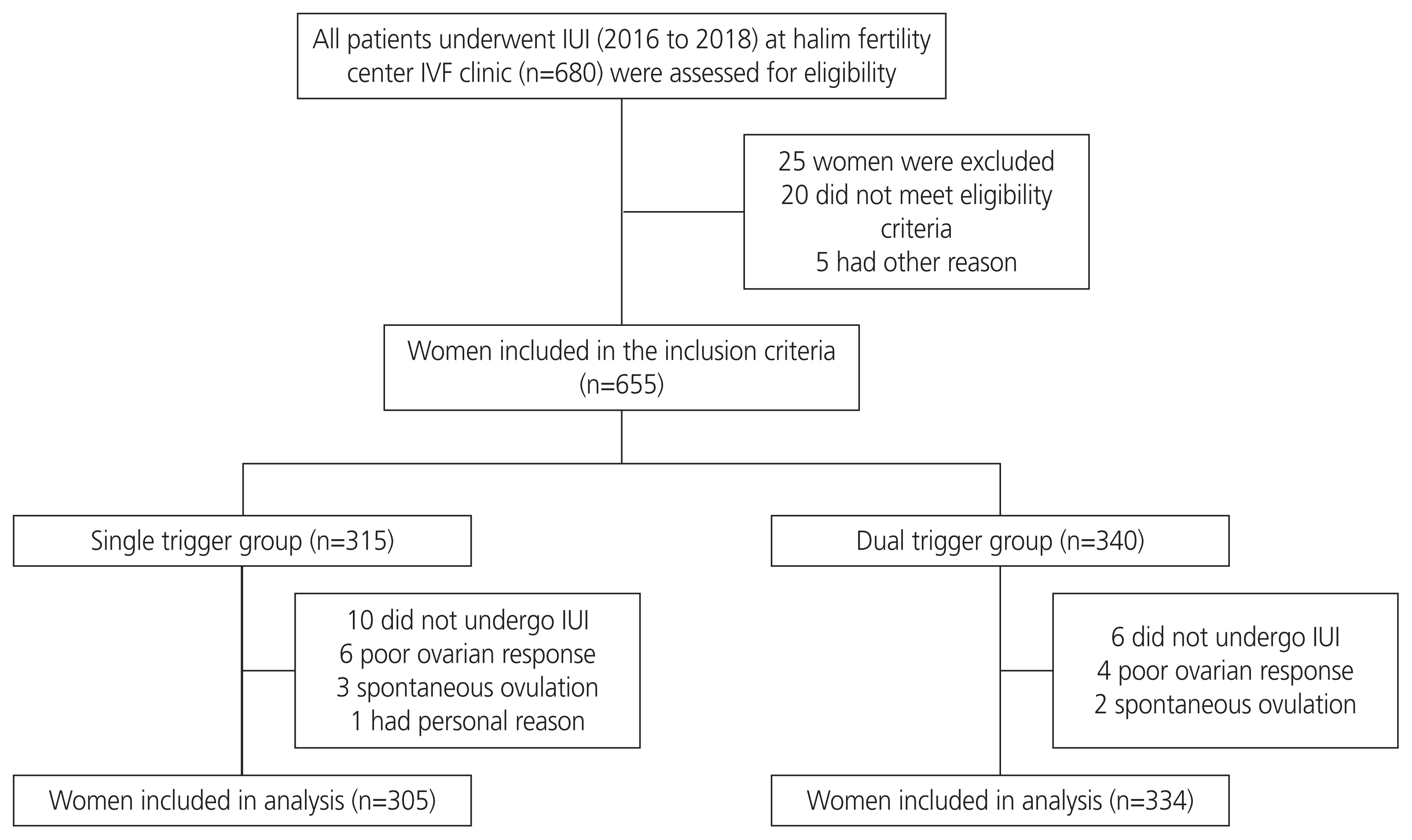1. Soliman BS, Siam S. Pregnancy rate after ovulation triggering with gonadotrophin releasing hormone agonist versus human chorionic gonadotrophin in women undergoing controlled ovarian stimulation/intrauterine insemination. Middle East Fertil Soc J. 2014; 19:262–7.

2. Weiss A, Beck-Fruchter R, Lavee M, Geslevich Y, Golan J, Ermoshkin A, et al. A randomized trial comparing time intervals from HCG trigger to intrauterine insemination for cycles utilizing GnRH antagonists. Syst Biol Reprod Med. 2015; 61:44–9.

3. Le MT, Nguyen DN, Zolton J, Nguyen VQH, Truong QV, Cao NT, et al. GnRH agonist versus hCG trigger in ovulation induction with intrauterine insemination: a randomized controlled trial. Int J Endocrinol. 2019; Mar. 13. [Epub].
https://doi.org/10.1155/2019/2487067
.

4. Farag AH, El-Deen MHN, Hassan RM. Triggering ovulation with gonadotropin-releasing hormone agonist versus human chorionic gonadotropin in polycystic ovarian syndrome. A randomized trial. Middle East Fertil Soc J. 2015; 20:217–23.

5. Lee JI, Hur YM, Jeon ES, Yoon JI, Jung GS, Hong KE, et al. Comparison of pregnancy rates by intrauterine insemination after ovulation trigger with endogenous LH surge, GnRH agonist or hCG in stimulated cycles. Clin Exp Reprod Med. 1999; 26:389–98.
6. Taheripanah R, Zamaniyan M, Moridi A, Taheripanah A, Malih N. Comparing the effect of gonadotropin-releasing hormone agonist and human chorionic gonadotropin on final oocytes for ovulation triggering among infertile women undergoing intrauterine insemination: An RCT. Int J Reprod Biomed. 2017; 15:351–6.

7. Andersen AG, Als-nielsen B, Hornnes PJ, Andersen LF. Time interval from human chorionic gonadotrophin (HCG) injection to follicular rupture. Hum Reprod. 1995; 10:3202–5.

8. Lin MH, Wu FS, Lee RK, Li SH, Lin SY, Hwu YM. Dual trigger with combination of gonadotropin-releasing hormone agonist and human chorionic gonadotropin significantly improves the live-birth rate for normal responders in GnRH-antagonist cycles. Fertil Steril. 2013; 100:1296–302.

9. Griffin D, Feinn R, Engmann L, Nulsen J, Budinetz T, Benadiva C. Dual trigger with gonadotropin-releasing hormone agonist and standard dose human chorionic gonadotropin to improve oocyte maturity rates. Fertil Steril. 2014; 102:405–9.

10. Fabris AM, Cruz M, Legidos V, Iglesias C, Muñoz M, García-Velasco JA. Dual triggering with gonadotropin-releasing hormone agonist and standard dose human chorionic gonadotropin in patients with a high immature oocyte rate. Reprod Sci. 2017; 24:1221–5.

11. Mahajan N, Sharma S, Arora PR, Gupta S, Rani K, Naidu P. Evaluation of dual trigger with gonadotropin-releasing hormone agonist and human chorionic gonadotropin in improving oocyte maturity rates: a prospective randomized study. J Hum Reprod Sci. 2016; 9:101–6.

12. Zhang J, Wang Y, Mao X, Chen Q, Hong Q, Cai R, et al. Dual trigger of final oocyte maturation in poor ovarian responders undergoing IVF/ICSI cycles. Reprod Biomed Online. 2017; 35:701–7.

13. Li S, Zhou D, Yin T, Xu W, Xie Q, Cheng D, et al. Dual trigger of triptorelin and HCG optimizes clinical outcome for high ovarian responder in GnRH-antagonist protocols. Oncotarget. 2018; 9:5337–43.

14. Chen CH, Tzeng CR, Wang PH, Liu WM, Chang HY, Chen HH, et al. Dual triggering with GnRH agonist plus hCG versus triggering with hCG alone for IVF/ICSI outcome in GnRH antagonist cycles: a systematic review and meta-analysis. Arch Gynecol Obstet. 2018; 298:17–26.

15. Ding N, Liu X, Jian Q, Liang Z, Wang F. Dual trigger of final oocyte maturation with a combination of GnRH agonist and hCG versus a hCG alone trigger in GnRH antagonist cycle for in vitro fertilization: a systematic review and meta-analysis. Eur J Obstet Gynecol Reprod Biol. 2017; 218:92–8.

16. Kol S, Humaidan P. GnRH agonist triggering: recent developments. Reprod Biomed Online. 2013; 26:226–30.

17. Youssef MA, Van der Veen F, Al-Inany HG, Mochtar MH, Griesinger G, Nagi Mohesen M, et al. Gonadotropin-releasing hormone agonist versus HCG for oocyte triggering in antagonist-assisted reproductive technology. Cochrane Database Syst Rev. 2014. 10:CD008046..

18. Orvieto R. Triggering final follicular maturation- hCG, GnRH-agonist or both, when and to whom? J Ovarian Res. 2015; 8:60.

19. Humaidan P, Bredkjaer HE, Bungum L, Bungum M, Grøndahl ML, Westergaard L, et al. GnRH agonist (buserelin) or hCG for ovulation induction in GnRH antagonist IVF/ICSI cycles: a prospective randomized study. Hum Reprod. 2005; 20:1213–20.

20. Scantamburlo VM, Linsingen RV, Centa LJR, Toso KFD, Scaraboto D, Araujo E Júnior, et al. Association between decreased ovarian reserve and poor oocyte quality. Obstet Gynecol Sci. 2021; 64:532–9.

21. Haas J, Zilberberg E, Dar S, Kedem A, Machtinger R, Orvieto R. Co-administration of GnRH-agonist and hCG for final oocyte maturation (double trigger) in patients with low number of oocytes retrieved per number of preovulatory follicles--a preliminary report. J Ovarian Res. 2014; 7:77.

22. Zilberberg E, Haas J, Dar S, Kedem A, Machtinger R, Orvieto R. Co-administration of GnRH-agonist and hCG, for final oocyte maturation (double trigger), in patients with low proportion of mature oocytes. Gynecol Endocrinol. 2015; 31:145–7.

23. Alyasin A, Mehdinejadiani S, Ghasemi M. GnRH agonist trigger versus hCG trigger in GnRH antagonist in IVF/ICSI cycles: a review article. Int J Reprod Biomed. 2016; 14:557–66.

24. Liu Conghui, Li Yu, Jiang Hong, Liu Yingchun, Song Xiaomin. The clinical outcomes of fresh versus frozen embryos transfer in women ≥40 years with poor ovarian response. Obstet Gynecol Sci. 2021; 64:284–92.

25. AboulGheit S. Pregnancy rates following three different timings of intrauterine insemination for women with unexplained infertility: a randomised controlled trial. Middle East Fertil Soc J. 2010; 15:265–8.





 PDF
PDF Citation
Citation Print
Print




 XML Download
XML Download